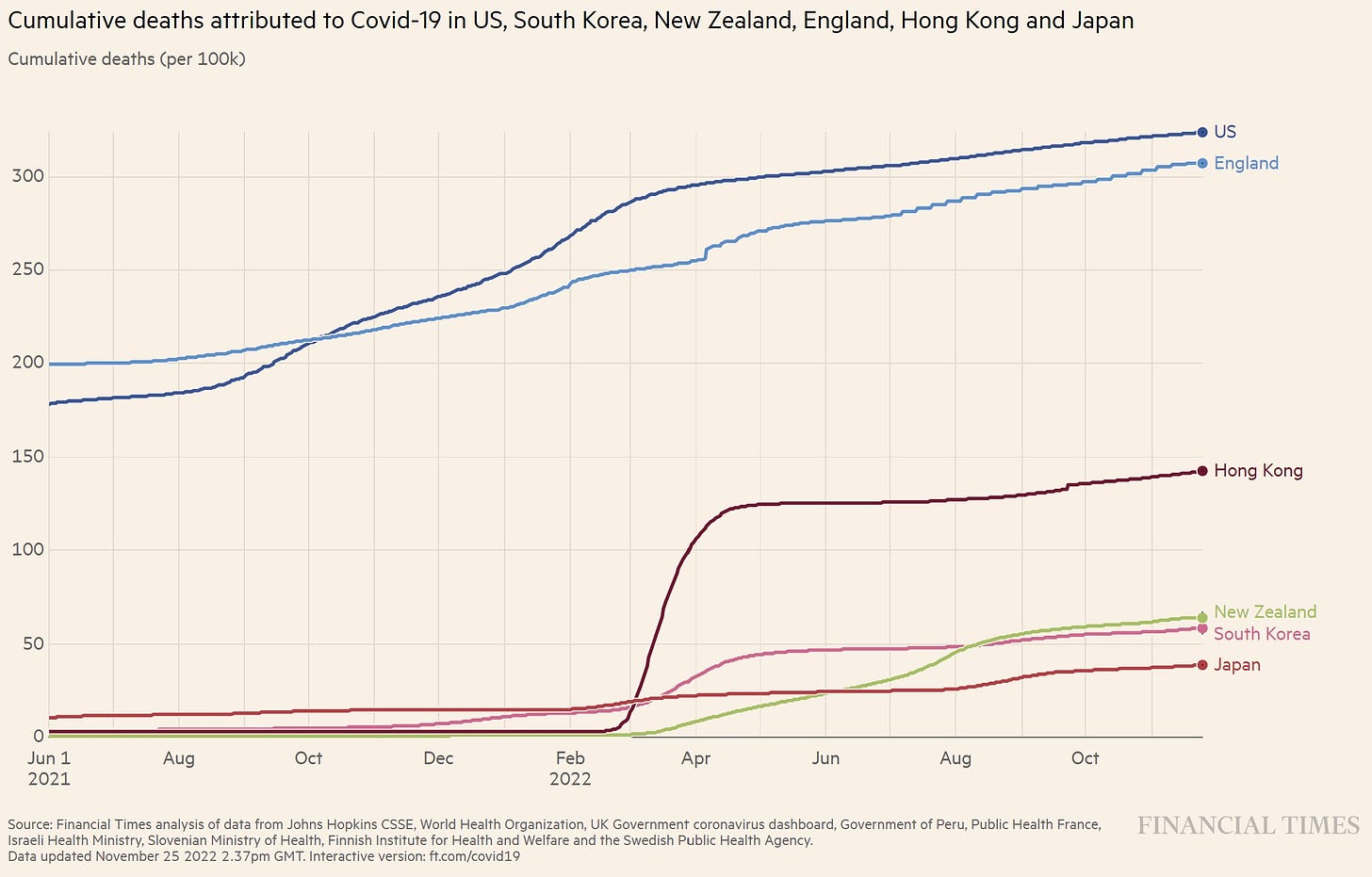After Omicron emerged as a highly contagious variant of concern, the majority of the world accepted a harm reduction strategy: get vaccines in as many arms as possible, then slowly open up. In many countries, this turned out to be a good public health strategy to reduce death, minimize stress on healthcare systems, improve quality of life, improve the economy, etc. However, China continues to attempt a zero-COVID strategy—very, very tight restrictions—in an attempt to stop all transmission.
While China’s strategy has an upside, like reduced deaths, reduced long COVID rates and decreased chances of mutations, it has massive downsides. It’s clear that the ever-stricter measures fail to keep up with more-transmissible variants while becoming increasingly costly to society. This has caused country-wide protests sparked by frustration, anger, discontent, and despair.
COVID-19 seems to be on the verge of exploding in China. They are reporting record-high numbers—nearly 40,000 new infections per day. The biggest concern is China’s incomplete immunity wall when faced with infections:
-
China does have a highly vaccinated population—about 90% are vaccinated with the primary series. This is higher than the United States. However, quality (not just quantity) of the vaccine is important. China rolled out Sinopharm and SinoVac—inactivated vaccines that are just not very effective against Omicron.
-
Their booster rate, and specifically who is boosted, is abysmal. Only 30% of 80+ year olds have one booster, for example. We have plenty of evidence showing the importance of boosters among the most vulnerable.
-
Infection-induced immunity is low. While preventing infections is the safest route, we have more than 30 studies showing hybrid immunity (vaccine + infection) builds a more complex immunity wall for the virus.
Last winter, we witnessed what Omicron could do in a population with an incomplete immunity wall—death rates in Hong Kong went vertical. It was simply disastrous.
What could happen across all of China? A scientific publication in Nature Medicine predicted a grim picture earlier this year. They ran a number of models with varied infection rates, booster rates, vaccine efficacy, the use of non-pharmaceutical interventions (like masks), and more. In conclusion, over a 6 month period, China would experience:
-
112.2 million symptomatic cases
-
2.7 million ICU admissions, exceeding their ICU capacity by 15.6 times
-
1.55 million deaths, 75% of them among those aged 60 years and older
Solution?
From a public health perspective, I’m not sure how this ends well for China, as there are very few ways out of this scenario.
The best option is to vaccinate as many people as possible, especially older adults, through a very intense, massive public health campaign. They are starting to do this, but too late. And, ideally, they would use mRNA vaccines. China has ~10 mRNA vaccines in the development pipeline, but to my knowledge, none are close to roll-out. My hope is that they will pivot to American vaccines, soon, but I’m not holding my breath. They could wait for second generation vaccines that stop transmission, but this will take a lot of time.
A vaccine campaign has challenges, too—mainly lack of trust. A great article covered why China has not implemented a vaccine mandate even though they implement other very strict measures: dramatic social resistance.
Japan has released scientific results of the first effective anti-viral for non-high risk people. I would pair this with Paxlovid, better ventilation, and masks and hope for the best.
In all, I think the situation in China is about more than public health. It’s about politics, control, autonomy from the West, and so much more, which makes solving the public health problem that much more difficult.
Global implications
If the flood gates open, there will be an impact on the economy. We’ve seen throughout the pandemic that healthy people equals a healthy economy. A massive outbreak in China would have a global cascading impact on supply chains.
It could also impact viral evolution. If COVID-19 takes hold in China, there will be little to stop the virus from jumping person-to-person in a network of 1.4 billion people—about 20% of the global population. Some mutations arise from persistent infection with immunocompromised people (we think this is how Omicron developed), but the more a virus jumps, the more opportunity it has to randomly mutate. This is how we got Delta, for example.
To add fuel to the fire, global COVID-19 surveillance is down 90%. So if we do get a mutated virus, we won’t have a lot of warning. In fact, we don’t even know which Omicron subvariant is causing the current wave in China.
“Your Local Epidemiologist (YLE)” is written by Dr. Katelyn Jetelina, MPH PhD—an epidemiologist, data scientist, wife, and mom of two little girls. During the day she works at a nonpartisan health policy think tank and is a senior scientific consultant to a number of organizations, including the CDC. At night she writes this newsletter. Her main goal is to “translate” the ever-evolving public health science so that people will be well equipped to make evidence-based decisions. This newsletter is free thanks to the generous support of fellow YLE community members.
You may subscribe by going to the publishing site of Your Local Epidemiologist.



Spread the word